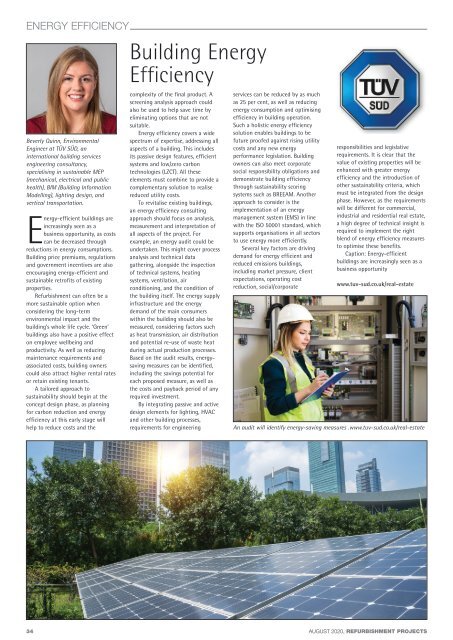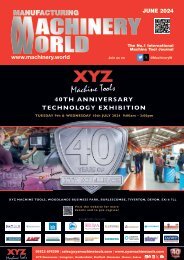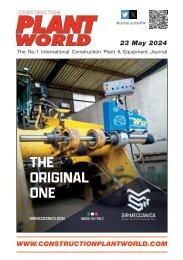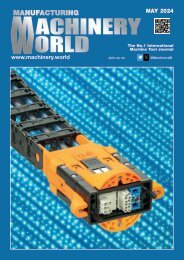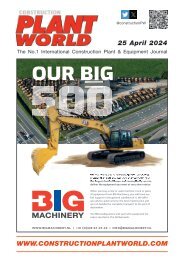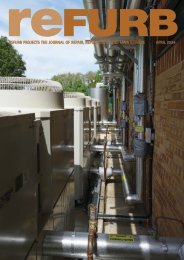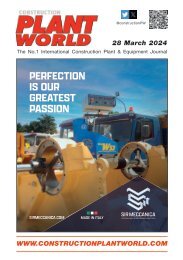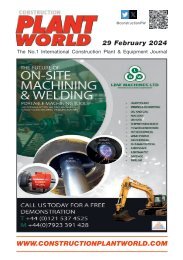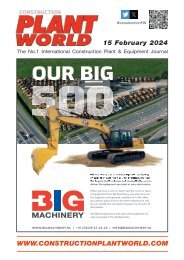Refurb Projects August 2020
Refurb Projects launched in 1987 to cater for the expanding Repair, Maintenance, Improvement and Refurb sectors of the UK Building Industry. This represents a massive market, with refurbishment in the Health, Leisure, Education and Social Housing sectors expecting to be the mainstay of the industry for the foreseeable future. Sustainability and the protection of the built environment are essential ingredients of the refurbishment market, and Refurb Projects Journal is a leader in reporting and promoting these ideals.
Refurb Projects launched in 1987 to cater for the expanding Repair, Maintenance, Improvement and Refurb sectors of the UK Building Industry.
This represents a massive market, with refurbishment in the Health, Leisure, Education and Social Housing sectors expecting to be the mainstay of the industry for the foreseeable future.
Sustainability and the protection of the built environment are essential ingredients of the refurbishment market, and Refurb Projects Journal is a leader in reporting and promoting these ideals.
Create successful ePaper yourself
Turn your PDF publications into a flip-book with our unique Google optimized e-Paper software.
ENERGY EFFICIENCY<br />
Building Energy<br />
Efficiency<br />
Beverly Quinn, Environmental<br />
Engineer at TÜV SÜD, an<br />
international building services<br />
engineering consultancy,<br />
specialising in sustainable MEP<br />
(mechanical, electrical and public<br />
health), BIM (Building Information<br />
Modelling), lighting design, and<br />
vertical transportation.<br />
Energy-efficient buildings are<br />
increasingly seen as a<br />
business opportunity, as costs<br />
can be decreased through<br />
reductions in energy consumptions.<br />
Building price premiums, regulations<br />
and government incentives are also<br />
encouraging energy-efficient and<br />
sustainable retrofits of existing<br />
properties.<br />
<strong>Refurb</strong>ishment can often be a<br />
more sustainable option when<br />
considering the long-term<br />
environmental impact and the<br />
building’s whole life cycle. ‘Green’<br />
buildings also have a positive effect<br />
on employee wellbeing and<br />
productivity. As well as reducing<br />
maintenance requirements and<br />
associated costs, building owners<br />
could also attract higher rental rates<br />
or retain existing tenants.<br />
A tailored approach to<br />
sustainability should begin at the<br />
concept design phase, as planning<br />
for carbon reduction and energy<br />
efficiency at this early stage will<br />
help to reduce costs and the<br />
complexity of the final product. A<br />
screening analysis approach could<br />
also be used to help save time by<br />
eliminating options that are not<br />
suitable.<br />
Energy efficiency covers a wide<br />
spectrum of expertise, addressing all<br />
aspects of a building. This includes<br />
its passive design features, efficient<br />
systems and low/zero carbon<br />
technologies (LZCT). All these<br />
elements must combine to provide a<br />
complementary solution to realise<br />
reduced utility costs.<br />
To revitalise existing buildings,<br />
an energy efficiency consulting<br />
approach should focus on analysis,<br />
measurement and interpretation of<br />
all aspects of the project. For<br />
example, an energy audit could be<br />
undertaken. This might cover process<br />
analysis and technical data<br />
gathering, alongside the inspection<br />
of technical systems, heating<br />
systems, ventilation, air<br />
conditioning, and the condition of<br />
the building itself. The energy supply<br />
infrastructure and the energy<br />
demand of the main consumers<br />
within the building should also be<br />
measured, considering factors such<br />
as heat transmission, air distribution<br />
and potential re-use of waste heat<br />
during actual production processes.<br />
Based on the audit results, energysaving<br />
measures can be identified,<br />
including the savings potential for<br />
each proposed measure, as well as<br />
the costs and payback period of any<br />
required investment.<br />
By integrating passive and active<br />
design elements for lighting, HVAC<br />
and other building processes,<br />
requirements for engineering<br />
services can be reduced by as much<br />
as 25 per cent, as well as reducing<br />
energy consumption and optimising<br />
efficiency in building operation.<br />
Such a holistic energy efficiency<br />
solution enables buildings to be<br />
future proofed against rising utility<br />
costs and any new energy<br />
performance legislation. Building<br />
owners can also meet corporate<br />
social responsibility obligations and<br />
demonstrate building efficiency<br />
through sustainability scoring<br />
systems such as BREEAM. Another<br />
approach to consider is the<br />
implementation of an energy<br />
management system (EMS) in line<br />
with the ISO 50001 standard, which<br />
supports organisations in all sectors<br />
to use energy more efficiently.<br />
Several key factors are driving<br />
demand for energy efficient and<br />
reduced emissions buildings,<br />
including market pressure, client<br />
expectations, operating cost<br />
reduction, social/corporate<br />
responsibilities and legislative<br />
requirements. It is clear that the<br />
value of existing properties will be<br />
enhanced with greater energy<br />
efficiency and the introduction of<br />
other sustainability criteria, which<br />
must be integrated from the design<br />
phase. However, as the requirements<br />
will be different for commercial,<br />
industrial and residential real estate,<br />
a high degree of technical insight is<br />
required to implement the right<br />
blend of energy efficiency measures<br />
to optimise these benefits.<br />
Caption: Energy-efficient<br />
buildings are increasingly seen as a<br />
business opportunity<br />
www.tuv-sud.co.uk/real-estate<br />
An audit will identify energy-saving measures .www.tuv-sud.co.uk/real-estate<br />
34 AUGUST <strong>2020</strong>, REFURBISHMENT PROJECTS


